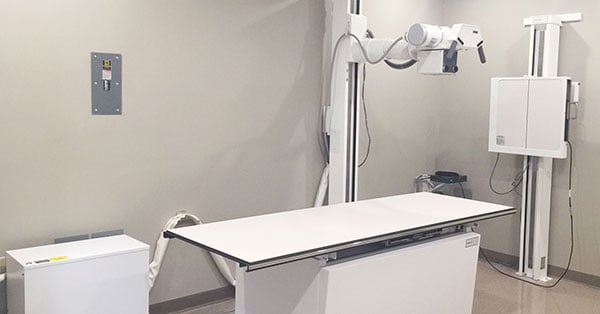While outfitting a veterinary practice with imaging equipment is very much like outfitting a practice that serves human patients, it pays to be aware of the particulars that set the process apart. Through our experiences working with veterinary practices, we've seen a number of well-laid plans change, adapt, or go back to the drawing board altogether because of one or more of these differences.
To help those of you who may be in the market for veterinary X-ray or C-arm machines, we want to share three considerations that many people overlook as they begin to plan their veterinary imaging equipment project. Paying attention to them and being just a little flexible in your planning can save you delays and headaches in the long run.
Before You Buy Veterinary X-Ray
Positioning
Because of the wide variety of patient body shapes and sizes a veterinarian sees, positioning can be a challenge with some X-ray systems. What works for scanning a Yorkshire terrier is probably not going to work for scanning a draft horse.
Keeping this in mind, it's wise to consider budgeting some positioning tools into your overall X-ray project. An adjustable-height table is a great start for practices that deal primarily with cats and dogs, but facilities seeing significant traffic for treatment of equine and bovine species may want to consider a ceiling-mounted trapeze or sling for limb suspension, as well as a heavy-duty patient lift for incapacitated large animals. If a facility plans to use mobile equipment like a C-arm or portable X-ray, it may be worth considering building a ramp to elevate the X-ray source.
Browse Surgical Tables for Sale
Power
In the case of C-arm systems, many veterinary facilities consider purchasing a mini-C. If your intent is to specialize in small animals- i.e. cats, rodents, most reptiles- a mini-C will probably be sufficient in both penetrating power and positioning. If, however, your patient base will be broader, a full-size C-arm might be a better pick. Aside from the fact that the chest cavities of many dog breeds will not fit in a mini-C (let alone most livestock species), mini-C systems do not generate sufficient power for their X-rays to penetrate the anatomy of larger animals. If your patient schedule will include horses, cows, alpacas, or other large livestock, a full-size C-arm will be necessary to scan them.
Financing
When additional items like positioning tools and higher-powered systems become part of your equipment project, you may find yourself needing to operate outside your original budget plan. Fortunately, many providers offer financing options that can get you the equipment power you need while still allowing the flexibility you need to add a table, ramp, or patient lift to the plan.
The Takeaway
Regardless of which species your facility will be serving, planning your first imaging equipment project can be a big job with more than a few surprises along the way. As you begin to prepare, our team is ready to help you choose the very best equipment to fit your needs. If your plans happen to change, we can help with that too. Use the button below to tell us about your project and get information/pricing for veterinary X-ray machines, C-arms, and surgical tables.

Tony Baggett
Tony Baggett is an X-Ray Product Manager at Block Imaging. Tony assists imaging centers, hospitals, and orthopedic centers in their purchases of x-ray equipment. When he’s not serving customers, Tony can be found hunting, fishing, and camping with his wife, son, and daughter.







